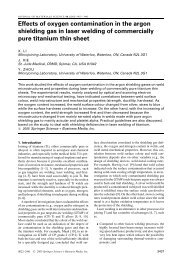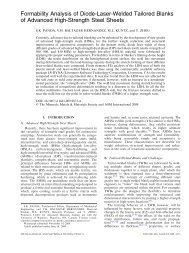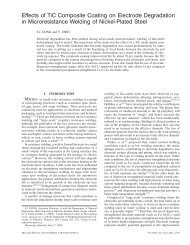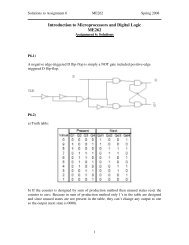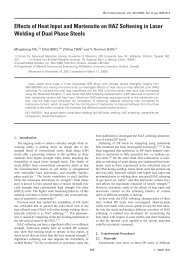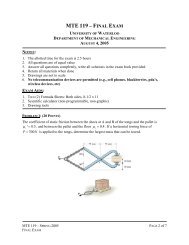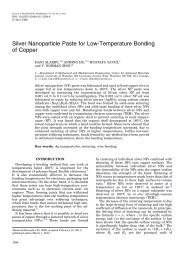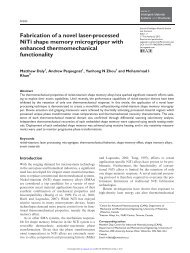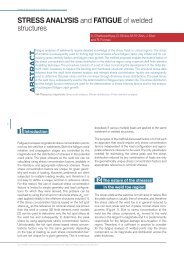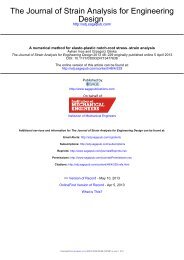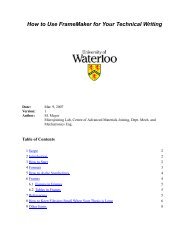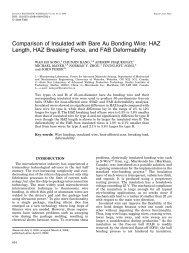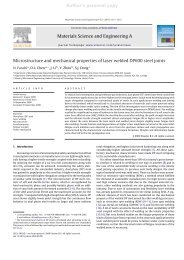Comparison of 5-Axis and 3-Axis Finish Machining of Hydroforming ...
Comparison of 5-Axis and 3-Axis Finish Machining of Hydroforming ...
Comparison of 5-Axis and 3-Axis Finish Machining of Hydroforming ...
You also want an ePaper? Increase the reach of your titles
YUMPU automatically turns print PDFs into web optimized ePapers that Google loves.
Int J Adv Manuf Technol (2001) 17:562–569© 2001 Springer-Verlag London Limited<strong>Comparison</strong> <strong>of</strong> 5-<strong>Axis</strong> <strong>and</strong> 3-<strong>Axis</strong> <strong>Finish</strong> <strong>Machining</strong> <strong>of</strong>Hydr<strong>of</strong>orming Die InsertsP. Gray 1 , S. Bedi 1 , F. Ismail 1 , N. Rao 1 <strong>and</strong> G. Morphy 21Department <strong>of</strong> Mechanical Engineering, University <strong>of</strong> Waterloo, Ontario, Canada; <strong>and</strong> 2 Vari-Form, Woodstock, Ontario, CanadaThe recent growth in hydr<strong>of</strong>orming technology has sparkedinterest in alternative methods to the current conventional diemanufacturing techniques. Hydr<strong>of</strong>orming dies typically haveshallow forming channels <strong>and</strong> open, low curvature surfaces,making them ideally suited for 5-axis machining. To fullyappreciate the benefits <strong>and</strong> to properly demonstrate the capabilities<strong>of</strong> 5-axis machining for hydr<strong>of</strong>orming dies, a comparison<strong>of</strong> 5-axis <strong>and</strong> 3-axis finish machining was done. Twohydr<strong>of</strong>orming die insert sets were machined on a 5-axismachine with a tilt/rotary table. The tool paths for 5-axismachining were generated using custom s<strong>of</strong>tware based on amodified form <strong>of</strong> a tool positioning strategy called the principalaxis method. The quality <strong>of</strong> generated 3-axis toolpaths wasverified against the machining times <strong>of</strong> a third set <strong>of</strong> dieinserts, similar to those machined in 5-axis, by an independentindustrial mould <strong>and</strong> die manufacturer using a 3-axis highspeedmachine. A comparison <strong>of</strong> the generated 3-axis pathsversus the 5-axis paths for one <strong>of</strong> the die inserts was madeusing total finish machining tool path lengths to eliminatedifferences in machines. The results show that the generated3-axis tool paths are longer than the 5-axis paths by at least247%. The paper discusses the different tool-path generationmethods along with the geometry <strong>of</strong> cusp formation <strong>and</strong> theeffect <strong>of</strong> tool selection. Methods to improve the 3-axis resultsare also presented.Keywords: 5-axis; <strong>Finish</strong> machining; High-speed machining;Hydr<strong>of</strong>orming; Sculptured surfaces; 3-axis; Toolpath1. IntroductionThere are many published works claiming significant advantages<strong>of</strong> 5-axis machining <strong>of</strong> sculpted surfaces over 3-axis[1–6]. The faster machining times <strong>and</strong> better surface finish in5-axis machining are achieved by using flat <strong>and</strong> radiusedcornerendmills instead <strong>of</strong> the ball-nose endmills favoured inCorrespondence <strong>and</strong> <strong>of</strong>fprint requests to: Dr. S. Bedi, Department <strong>of</strong>Mechanical Engineering, University <strong>of</strong> Waterloo, Waterloo, Ontario,Canada, N2L 3G1. E-mail: sbedisurya.uwaterloo.ca3-axis finish machining. The extra two axes <strong>of</strong> a 5-axis machineare used to adjust the tilt <strong>and</strong> rotation (i.e. orientation) <strong>of</strong> thetool with respect to the surface normal at the machining pointson the workpiece. When a flat or corner-radius endmill istilted, the curvature cut by the edge geometry <strong>of</strong> the tool onthe workpiece is altered. This means that the curvature <strong>of</strong> thedesigned surface at the point being machined, can be matchedmore closely, which reduces the number <strong>of</strong> passes required tomachine the surface <strong>and</strong> lowers the cusp height <strong>and</strong> density.Two methods <strong>of</strong> tool positioning have been developed at theUniversity <strong>of</strong> Waterloo: multi-point machining <strong>and</strong> the principalaxis method. In multi-point machining (MPM) a flat orradiused-corner endmill is positioned on a surface such that itgenerates the designed surface at two separate points simultaneously[1]. The principal axis method (PAM) extracts curvaturedata from the design surface <strong>and</strong> calculates the requiredtilting <strong>of</strong> a flat or radiused-corner endmill to match the curvatureat the point being machined [2,3]. Another method is theSturz method, sometimes referred to as the inclined tool method[4,7]. In this method, the tool axis is inclined at a constantangle with respect to the surface normal for the entire surface.Workers involved in the above methods have favoured theapproach <strong>of</strong> comparing computer simulations <strong>of</strong> 3- <strong>and</strong> 5-axismethods because <strong>of</strong> the cost involved in actual machining,<strong>and</strong>, in most cases, the limited access to full simultaneous 5-axis milling machines. The samples that have been used forcomparison are usually simple surfaces or a fraction <strong>of</strong> anactual industrial part. The issues involved with die <strong>and</strong> mouldmanufacturing such as interference, gouging, depth <strong>of</strong> thesurfaces, depth <strong>of</strong> cut, <strong>and</strong> the machining <strong>of</strong> several connectedsurfaces found in real parts are not all simultaneously addressedby these simulations <strong>and</strong> laboratory surfaces. This paper documentsthe machining <strong>of</strong> hydr<strong>of</strong>orming die inserts in 5-axis, fora comparison with 3-axis finish machining. The inserts havesince been used to produce test parts by the company thatoriginally issued the study. Figures 1 <strong>and</strong> 2 show samples <strong>of</strong>the female <strong>and</strong> male sides <strong>of</strong> the hydr<strong>of</strong>orming die inserts.The basis for comparing the tool paths in 3-axis <strong>and</strong> 5-axiswill be the total finish machining tool-path length. Tool pathsfor 3-axis were generated with one <strong>of</strong> the leading commercialcomputer-aided manufacturing (CAM) packages. An independentmould <strong>and</strong> die manufacturer was commissioned to
<strong>Finish</strong> <strong>Machining</strong> <strong>of</strong> Hydr<strong>of</strong>orming Die Inserts 563Fig. 1. Female hydr<strong>of</strong>orming die insert.flank milling <strong>and</strong> in one set-up. Also, the bottom <strong>of</strong> theforming channel can be machined quickly <strong>and</strong> accurately withno cusps, using the bottom <strong>of</strong> the milling cutter. The constantradius along each <strong>of</strong> the four edges <strong>of</strong> the tube can be machinedeasily with a corner radius endmill in one pass while flankmilling the forming channel walls.The mating surfaces <strong>of</strong> the dies are curved surfaces becausethey follow the material flow along the formed part (Fig. 1).The surfaces are open <strong>and</strong> have low curvatures, making themideal c<strong>and</strong>idates for 5-axis machining. The open surfaces ensurethat there will be no interference with the tool when orientingthe tool axis. Low curvature surfaces can be cut with largediameter endmills which means that large cross-feeds can beused, resulting in very short machining times for very smallcusps. The low curvature also reduces the risk <strong>of</strong> gouging.The simple geometry <strong>of</strong> the forming channels combined withvery shallow <strong>and</strong> low curvatures <strong>of</strong> the mating surfaces makesthe machining <strong>of</strong> hydr<strong>of</strong>orming dies an ideal application for5-axis machining.3. Cusp FormationWhenever a curved surface is machined with a ball-nose orcorner radius endmill, cusps are left on the surface owing tothe cross-feed, the radius <strong>of</strong> the tool, <strong>and</strong> the curvature <strong>of</strong> thesurface (Fig. 3). With 5-axis machining, the two rotationalaxes can be used to tilt the tool such that the effective radius<strong>of</strong> the tool matches or approximates to that <strong>of</strong> the local radiusFig. 2. Male hydr<strong>of</strong>orming die insert.machine a similar set <strong>of</strong> die inserts using a 3-axis high-speedmachine. The machining times recorded by the manufacturerwere used to verify the machining time <strong>of</strong> the 3-axis pathsgenerated for the comparison.2. 5-<strong>Axis</strong> <strong>Machining</strong> <strong>of</strong> Hydr<strong>of</strong>orming DiesThe purpose <strong>of</strong> hydr<strong>of</strong>orming is to change the cross-section <strong>of</strong>a tube from round to rectangular. Though other cross-sectionsare possible, they are rare. Water pressure is used to exp<strong>and</strong>the tube walls to conform to that <strong>of</strong> the forming channel <strong>of</strong>the hydr<strong>of</strong>orming die. Thus, the deepest depth in the die isapproximately the diameter <strong>of</strong> the formed tube, the largestbeing typically no more than 150 mm in diameter. Theseshallow depths can be machined easily with 5-axis machineswithout the problems <strong>of</strong> interference <strong>of</strong> the tool shank(crashing) when orienting the tool. Since the cross-section istypically rectangular in shape, the forming channel wall <strong>and</strong>floor will be perpendicular. This means that with a 5-axismachine, the forming wall can be machined in one pass byFig. 3. Cusp formation.
564 P. Gray et al.<strong>of</strong> curvature at the point being machined on the surface (Fig.4) [2,3]. With this method, smaller cusps are generated, but,more importantly, the intended surface can be machined moreclosely, resulting in a more accurate surface.4. Tool Path Generation Methods4.1 5-<strong>Axis</strong> MethodsThere are not many commercial CAM packages available todaythat are capable <strong>of</strong> producing 5-axis tool paths. The ones thatare capable <strong>of</strong> doing so do not currently perform curvaturematching <strong>of</strong> the tool with respect to the design surface. Sometool positioning strategies available are summarised in thefollowing subsections.4.1.1 Sturz or Inclined ToolCAM package developers favour this method because it isrelatively simple computationally. In this method, an arbitraryinclination angle <strong>of</strong> the tool axis with respect to the surfacenormal is selected <strong>and</strong> applied to a flat or radiused-cornerendmill at all points on the workpiece. If the angle is toosmall, gouging may occur, <strong>and</strong> if the angle is too large,excessively large cusps remain [1,3]. Research is currentlyunderway to optimise <strong>and</strong> change the inclination angle dynamically[8]. Even with the arbitrary process, significant reductionsin machining times have been realised, compared to 3-axismachining with the same size ball-nose endmill [4,7].4.1.2 MultipointIn this method the cutter is oriented such that it contacts thedesign surface at two points simultaneously. The distancebetween the two contact points is arbitrarily selected. Themethod can work only with flat or radiused-corner endmillsbecause tilting a ball-nose endmill will not affect the geometryseen by the surface; it will always be spherical. The problemwith this method is that it is difficult <strong>and</strong> complex toimplement, also, many <strong>of</strong> the parameters involved remain tobe studied. One advantage is that gouge avoidance is built intothe algorithm.4.1.3 Principal <strong>Axis</strong>Given a fully defined surface, the local curvature at any pointmay be calculated. At any point on a curved surface there willbe a local maximum <strong>and</strong> minimum curvature. The vectors thatare tangential in the direction <strong>of</strong> the maximum <strong>and</strong> minimumcurvature at the defined point are the principal axes. It hasbeen shown that these three vectors (the normal <strong>and</strong> the twoprincipal axes vectors) are all perpendicular [2]. In the principalaxis method, the tool is tilted such that the effective tool radiusseen by the surface is matched to its maximum curvature atthe point being machined. The feed direction is along theminimum curvature. Like the multi-point method, the principalaxis method is not effective with ball-nose endmills. The mainproblems with this method include potential gouging, <strong>and</strong> thetool paths generated may not be practical or efficient becausethe feed direction must always follow the direction <strong>of</strong> minimumcurvature.4.1.4 Modified Principal <strong>Axis</strong>A study <strong>of</strong> the effect <strong>of</strong> feed direction with the principal axismethod was conducted by Rao et al. [2]. It has been shownthat the direction <strong>of</strong> minimum curvature is not necessarily thebest or most practical direction <strong>of</strong> feed as it can vary wildlyover complicated surfaces because the curvature typicallychanges over the surface. Two problems may arise from followingthe direction <strong>of</strong> minimum curvature: excessive jerk <strong>of</strong> themachine’s axes, <strong>and</strong> unintuitive, inefficient tool paths may begenerated. In the modified principal axis method, described indetail in [2], the principal curvatures <strong>and</strong> directions are nolonger used. A feed direction is selected based on the partgeometry; typical choices for machining passes include isoparametric<strong>and</strong> <strong>of</strong>fset Cartesian planes. Curvature is now calculatedin a plane perpendicular to the feed direction. It is thiscurvature that is used to determine the tilt angle <strong>of</strong> the tool.If the calculated tool position produces gouging, it is modifiedby increasing the tilt angle to avoid gouging. This modifiedmethod thus addresses the problems <strong>of</strong> gouging <strong>and</strong> the restrictionson the feed direction <strong>of</strong> the principal axis method.4.2 3-<strong>Axis</strong> MethodsThere are several conventional methods for surface machiningin 3-axis, common to most CAM packages. A quick survey<strong>of</strong> the top CAM packages on the market will show thateach provides similar tool-path generation methods for finishmachining in 3-axis. The characteristics <strong>of</strong> three <strong>of</strong> the mostcommon methods are discussed in the following subsections.Fig. 4. Curvature matching with 5-axis.4.2.1 ContourThis method intersects the surface with planes parallel to themachine worktable in increasing Z-depths until the bottom <strong>of</strong>the surface is reached. The contour line formed at the intersection<strong>of</strong> the plane <strong>and</strong> the surface outlines the path for the toolfor each specified depth, <strong>and</strong> Z-level machining is used to cut
<strong>Finish</strong> <strong>Machining</strong> <strong>of</strong> Hydr<strong>of</strong>orming Die Inserts 565the part. This is a very good technique for rough machiningbecause the Z-depth for each pass is constant, which meansthe machine is cutting in its most rigid state. For finishmachining it is less desirable because the geometry <strong>of</strong> theremaining cusps between the passes can vary considerably,making h<strong>and</strong> polishing very difficult.4.2.2 Surface FlowA constant uniform cusp over the machined surface is theobjective <strong>of</strong> this method. To achieve this the cross-feed forthe area <strong>of</strong> largest curvature <strong>of</strong> the surface is calculated for aspecified maximum cusp height. This value becomes the arclength between each pass on the surface. This only approximatesa constant cusp over the surface. The feed directionfollows either the constant u or v lines <strong>of</strong> the NURB surfaceswhich are indicative <strong>of</strong> the flow <strong>of</strong> the surface. Patches <strong>of</strong>connected surfaces with similar surface flows are selected <strong>and</strong>programmed. Thus, areas <strong>of</strong> the workpiece <strong>of</strong> similar surfaceflow are programmed together. Patches that are not connectedsmoothly (having the same curvature along their intersectionline) or do not have similar surface flows must be programmedseparately. A poorer surface finish results <strong>and</strong> the risk <strong>of</strong>gouging increases. It also reduces the efficiency <strong>of</strong> cutting <strong>and</strong>increases the programming time. Extra care must be used withthis method because <strong>of</strong> the increased complexity involved incalculating the tool position. Gouging <strong>and</strong> crashing <strong>of</strong> the toolis common.4.2.3 ParallelThis method generates parallel passes over the selected surfaces.The surfaces are scanned for the minimum cross-feedrequired to produce the maximum cusp height specified. Thevalue for the cross-feed is applied to each parallel pass. It isquick <strong>and</strong> easy to program <strong>and</strong> is a very reliable method,especially if using ball-nose endmills. The drawback <strong>of</strong> thismethod is that constant, uniform cusps will not necessarily begenerated on curved surfaces.Fig. 5. 3-<strong>Axis</strong> contour rough machined die insert.5.1 Rough <strong>Machining</strong>Four blocks <strong>of</strong> 44W hot rolled steel were rough machined ona 3-axis OKK machining centre to the approximate shape <strong>of</strong>the inserts in vertical contoured steps <strong>of</strong> 1.5875 mm (Figs 5<strong>and</strong> 6).5.2 5-<strong>Axis</strong> <strong>Machining</strong>For the mating surfaces, an indexible 38.1 mm diametershoulder/facemill with 6.35 mm radius round inserts was used.For the forming channel, a 25.4 mm diameter endmill wasused, with a corner radius ground to 6.5 mm.The modified principal axis method was used to create thetool paths. The modifications allow the programmer to controlthe direction <strong>of</strong> cutting. The paths used are shown in Fig. 7.<strong>Machining</strong> in a zigzag pattern would have reduced the machiningtimes. However, with the zigzag pattern, the surface finish5. <strong>Comparison</strong> <strong>of</strong> 5-<strong>Axis</strong> <strong>and</strong> 3-<strong>Axis</strong> ToolPathsTo eliminate differences between machines (i.e. horsepower,rapid travel speeds, rigidity, etc.) the basis for comparison usedin the present work is the total tool-path length required t<strong>of</strong>inish machine the die inserts. Three-axis tool paths weregenerated using a commercial CAM s<strong>of</strong>tware package. Only avisual check using a wireframe tool-path simulation was usedto check for gouging <strong>and</strong> for crashing <strong>of</strong> the tool. The toolpaths were not used for actual machining <strong>of</strong> the die inserts.However, machining times for a similar die insert set from anindependent die manufacturer were used to verify the quality<strong>of</strong> the 3-axis simulated tool paths. The 5-axis tool paths weregenerated at the University <strong>of</strong> Waterloo with custom s<strong>of</strong>twareusing a modified form <strong>of</strong> the principal axis method. These toolpaths were used to finish machine two die insert sets on aretr<strong>of</strong>itted Rambaudi 5-axis rotary/tilt table milling machine.Fig. 6. 3-<strong>Axis</strong> contour rough machined die insert.
566 P. Gray et al.Fig. 7. 5-<strong>Axis</strong> finish tool paths used. A, mating surface; B, formingchannel; C, mating surface.would be less uniform because the cutting conditions wouldbe alternating between up <strong>and</strong> down milling with each pass.The small mating surface identified in Fig. 7 as surface Cwas a problem for the principal axis method. It is actually apatch <strong>of</strong> three surfaces trimmed at their intersections (Fig. 8).The problem lies in the fact that the slopes <strong>of</strong> the surfacesare discontinuous at the trim lines where they intersect (i.e.their tangents did not match at the lines <strong>of</strong> intersection).Continuity is required for the calculations performed for thecurvature matching <strong>of</strong> the tool to the surface being machined<strong>and</strong> for tool positioning. Figure 9 shows an alternative path.Although this path gives the minimum number <strong>of</strong> passes, thetool must undergo large rotations at the surface intersectionline, which would gouge the surface at that point. To avoidthe problem <strong>of</strong> gouging, the path shown in Fig. 7 was used.Fig. 9. Alternative 5-axis tool path for mating surface C.Another way to avoid this problem is to design the surfacedifferently. The edges <strong>of</strong> the surface were trimmed to a point.If the surfaces were designed by translating the parting line<strong>of</strong> the forming channel to outside the die <strong>and</strong> then trimmingthe surfaces at the edge <strong>of</strong> the die (Fig. 10), a shorter toolpath could be generated than that shown in Fig. 7.5.2.1 5-<strong>Axis</strong> <strong>Finish</strong> <strong>Machining</strong> ResultsThe cusps produced during the finish operation did not exceed0.1016 mm for the mating surfaces <strong>of</strong> both the die insert sets.The forming channels were machined exactly to size withoutany cusps. Figures 11 <strong>and</strong> 12 are photographs <strong>of</strong> the finishmachined die inserts.5.3 3-<strong>Axis</strong> <strong>Machining</strong>The typical industrial practice for finish machining <strong>of</strong> curvedsurfaces is to use ball-nose endmills because they are easierto program than radius corner endmills <strong>and</strong> they leave auniform cusp on the surface [1]. Programs generated for thesetools are robust <strong>and</strong> reliable <strong>and</strong> gouging <strong>of</strong> the surfaces ishighly unlikely.Many CAM packages can generate tool paths for radiusedcorner endmills but they may not necessarily be useful orefficient. Often, the positioning strategy employed is to cut thesurface using the radiused corner <strong>of</strong> the tool. This willFig. 8. Mating surface trim lines.Fig. 10. Alternative surface construction method.
<strong>Finish</strong> <strong>Machining</strong> <strong>of</strong> Hydr<strong>of</strong>orming Die Inserts 569it is not common practice in industry, it was not investigatedin the current study.6. ConclusionThis work has shown the advantages <strong>of</strong> using 5-axis machiningin the production <strong>of</strong> hydr<strong>of</strong>orming dies; the mating surfaces areshallow <strong>and</strong> <strong>of</strong> low curvature, <strong>and</strong> the forming channels aretypically <strong>of</strong> very simple geometry. To the best <strong>of</strong> our knowledge,this paper presents the first investigation to highlight the application<strong>of</strong> the new 5-axis machining method to the exp<strong>and</strong>ing newtechnology <strong>of</strong> hydr<strong>of</strong>orming. Only total tool-path length was usedin the present investigation to compare 5-axis with 3-axis machining.Other parameters such as tool wear <strong>and</strong> machining dynamicsshould also be included in further studies.AcknowledgementThis research was funded in part by the Industrial Research<strong>and</strong> Development Institute <strong>of</strong> Midl<strong>and</strong>, Ontario, Canada, <strong>and</strong>Materials Manufacturing <strong>of</strong> Ontario, Canada.References1. A. Warkentin, “Multi-point machining <strong>of</strong> sculpted surfaces”,Thesis, University <strong>of</strong> Waterloo, Waterloo, Ontario, Canada,1997.2. N. Rao, F. Ismail <strong>and</strong> S. Bedi, “Tool path planning for five-axismachining using the principle axis method”, International Journal<strong>of</strong> Machine Tools Manufacturing, 37(7), pp. 1025–1040, 1997.3. N. Rao, “Implementation <strong>of</strong> the principal axis method for machining<strong>of</strong> sculpted surfaces”, thesis, University <strong>of</strong> Waterloo, Waterloo,Canada, 1997.4. G. W. Vickers <strong>and</strong> K. Quan, “Ball-mills versus end-mills forcurved surface machining”, ASME Journal <strong>of</strong> Engineering forIndustry, 111, pp. 22–26, February 1989.5. S. Bedi, F. Ismil, M. J. Mahjoob <strong>and</strong> Y. Chen, “Toroidal versusball nose <strong>and</strong> flat bottom end mills”, International Journal <strong>of</strong>Advanced Manufacturing Technology, 13, pp. 326–332, 1997.6. E. Sprow, “Should we? Could we? Step up to five-axis programming”,Manufacturing Engineering, November 1993.7. G. W. Vickers <strong>and</strong> S. Bedi, “The definition <strong>and</strong> manufacture <strong>of</strong>compound curvature surfaces using G-surf”, Computers in Industry,6, pp. 173–183, 1985.8. J. P. Kruth <strong>and</strong> P. Klewais, “Optimization <strong>and</strong> dynamic adaptation<strong>of</strong> the cutter inclination during five-axis milling <strong>of</strong> sculpturedsurfaces”, Annals CIRP, 43(1), pp. 443–448, 1994.9. F. Mason, “Die <strong>and</strong> mold finishing, how fast?”, ManufacturingEngineering, September 1995.



